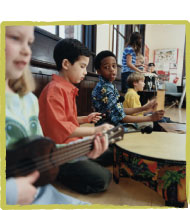|
 Neuroscience and learning Neuroscience and learning
During the brain’s early years, neural connections are made at a rapid rate. Much of what young children do as play—singing, dancing, painting, drawing, acting—are natural forms of art. I see this in my daughter Tess every day. She learns through play: artistic play. In fact, it’s how she learned her ABC’s. High-quality early childhood programs are grounded in the arts, play, and experiential learning.
When children enter school, art experiences must continue. As Dr. Bob Sylwester, professor emeritus at the University of Oregon, writes, “The arts are not just expressive and affective, they are deeply cognitive. They develop critical thinking skills—pattern recognition and development; mental representations of what is observed or imagined; symbolic, allegorical, and metaphorical representations; careful observation of the world; and abstraction from complexity.” Tess can’t explain her process of learning in those terms, but she can describe some of what is listed here as she finger-paints the portraits of The Wiggles. She does it with dance, too, as she romp bompa chomps her favorite Dorothy the Dinosaur dance. She is not only mimicking behavior; she’s engaged in improvisational dance.
What’s the implication for schooling in the beginning of the new millennium? We must think differently about teaching and learning.
|
Policy implications
Time magazine (December 18, 2006) reported in an article titled, “How to Build a Student for The 21st Century”:
For the past five years, the national conversation on education has focused on reading scores, math tests, and closing the “achievement gap” between social classes. This is not a story about that conversation. This is a story about the big public conversation the nation is not having about education, the one that will ultimately determine not merely whether some fraction of our children get ‘left behind’ but also whether an entire generation of kids will fail to make the grade in a global economy because they can’t think their way through abstract problems, work in teams, distinguish good information from bad or speak a language other than English.... Today’s economy demands not only high-level competence in the traditional academic disciplines but also what might be called 21st Century Skills.
What are those millennial skills?
1. Knowing more about the world. Kids need to learn how to act as global citizens, particularly in this increasingly complex, global economy.
2. Thinking outside the box. Kids need to know how to leap across disciplines, because that is how breakthroughs now happen. Interdisciplinary thinking, synthesis, and making connections result in innovation.
3. Becoming smarter about new sources of information. Kids need to learn how to rapidly process information and distinguish between what’s reliable and what’s unreliable. In a world where information access is ubiquitous, discernible use is essential.
4. Developing good people skills. A 21st century education isn’t just about IQ. Kids need to develop their EQ, or emotional intelligence. They also must develop communication skills, empathy skills, relationship skills, teamwork skills, and cultural competency skills.
How does our state test, the Washington Assessment of Student Learning (WASL) measure any of these millennial skills? It doesn’t. It’s too narrow.
|
Continued 1 | 2 | 3 | 4 | 5 |
|
 |